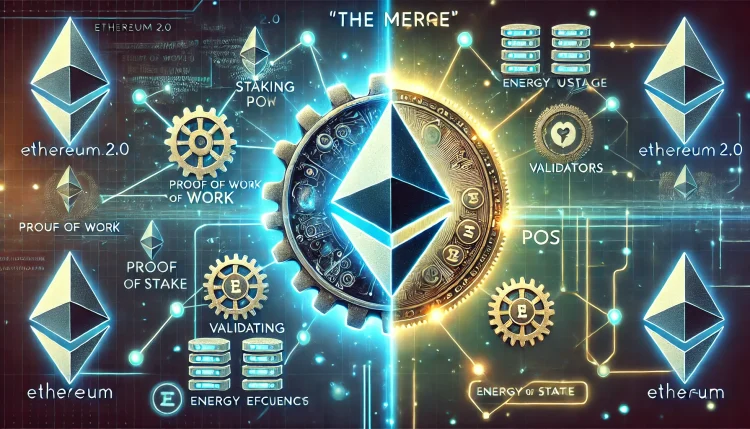Table of Contents
- Introduction
- What is Ethereum 2.0?
- The Road to Ethereum 2.0
- Understanding the Merge
- Key Benefits of Ethereum 2.0
- Challenges and Concerns
- Impact on Ethereum Users and Developers
- The Future of Ethereum Post-Merge
- Frequently Asked Questions
- Conclusion
Introduction
Ethereum, the world’s second-largest cryptocurrency by market capitalization, has undergone a significant transformation known as “The Merge.” This event marks a crucial milestone in the evolution of the Ethereum network, transitioning from a proof-of-work (PoW) consensus mechanism to a proof-of-stake (PoS) system. The Merge is a critical component of the broader Ethereum 2.0 upgrade, which aims to make the network more scalable, secure, and sustainable.
In this comprehensive guide, we’ll delve into the intricacies of Ethereum 2.0 and the Merge, exploring what these changes mean for the future of decentralized finance (DeFi), non-fungible tokens (NFTs), and the broader blockchain ecosystem.
What is Ethereum 2.0?
Ethereum 2.0, also known as Eth2 or Serenity, is a series of upgrades to the Ethereum network designed to enhance its scalability, security, and sustainability. These upgrades are necessary to address the limitations of the original Ethereum blockchain, which has faced challenges in handling increased transaction volumes and rising gas fees.
The key components of Ethereum 2.0 include:
- Beacon Chain: Introduced in December 2020, the Beacon Chain is the cornerstone of Ethereum’s new PoS system. It coordinates the network of stakers and serves as the central ledger for Ethereum 2.0.
- The Merge: This event represents the joining of the original Ethereum mainnet with the Beacon Chain, officially transitioning the network from PoW to PoS.
- Shard Chains: Planned for future implementation, shard chains will distribute the network’s load across multiple parallel chains, significantly increasing Ethereum’s transaction processing capacity.
The Road to Ethereum 2.0
The journey to Ethereum 2.0 has been long and complex, involving several phases:
Phase 0: Beacon Chain Launch (December 2020)
The Beacon Chain went live on December 1, 2020, marking the beginning of Ethereum’s transition to PoS. This chain ran parallel to the original Ethereum mainnet and did not affect day-to-day operations on the network.
Phase 1: The Merge (September 2022)
The Merge, completed on September 15, 2022, combined the original Ethereum mainnet with the Beacon Chain, officially transitioning the network to PoS.
Future Phases
Subsequent phases will focus on implementing shard chains and other optimizations to further enhance the network’s capabilities.
Understanding the Merge
The Merge is arguably the most significant event in Ethereum’s history since its inception. Here’s what you need to know:
What Exactly is the Merge?
The Merge refers to the joining of the original Ethereum execution layer (the mainnet as we knew it) with its new proof-of-stake consensus layer, the Beacon Chain. This eliminated the need for energy-intensive mining and enabled the network to be secured using staked ETH instead.
Key Changes Introduced by the Merge:
- Consensus Mechanism: Transition from proof-of-work to proof-of-stake.
- Energy Efficiency: Dramatic reduction in energy consumption (estimated at ~99.95%).
- Staking: ETH holders can now stake their tokens to become validators and earn rewards.
- Issuance Reduction: Decrease in the rate of new ETH issuance.
What Didn’t Change with the Merge:
- Transaction Speed: The Merge did not significantly impact transaction speed or gas fees.
- Smart Contract Functionality: Existing smart contracts and dApps continued to function as before.
- User Experience: For most users and developers, the transition was seamless with no action required.
Key Benefits of Ethereum 2.0
The transition to Ethereum 2.0 brings several significant advantages:
1. Enhanced Sustainability
By moving to PoS, Ethereum has dramatically reduced its energy consumption, addressing one of the major criticisms of blockchain technology.
2. Improved Security
The PoS system introduces new security mechanisms, making it more costly and difficult to attack the network.
3. Increased Scalability (Future)
While not immediately implemented with the Merge, future upgrades including shard chains will significantly increase Ethereum’s transaction processing capacity.
4. Lower Barrier to Participation
Staking allows more Ethereum holders to participate in network security and earn rewards, unlike the hardware-intensive mining of PoW.
5. Deflationary Pressure on ETH
The reduced issuance rate combined with the burning of transaction fees (implemented in EIP-1559) could lead to a deflationary environment for ETH.
Challenges and Concerns
Despite its benefits, the transition to Ethereum 2.0 is not without challenges:
1. Technical Complexity
The upgrade process is highly complex, requiring careful coordination among developers, node operators, and other stakeholders.
2. Centralization Concerns
Some critics argue that PoS may lead to increased centralization, as those with more ETH have more influence over the network.
3. Regulatory Uncertainty
The change to PoS has reignited discussions about whether ETH could be classified as a security under certain regulatory frameworks.
4. Short-term Scalability Limitations
While the Merge sets the stage for future scalability improvements, it doesn’t immediately solve Ethereum’s congestion issues.
Impact on Ethereum Users and Developers
For most Ethereum users and developers, the Merge had minimal immediate impact:
Users:
- No action was required to upgrade or migrate tokens/ETH.
- Transaction processes and wallet interactions remained largely unchanged.
- Users gained the ability to stake ETH and participate in network security.
Developers:
- Existing smart contracts and dApps continued to function without modification.
- Development tools and processes remained largely the same.
- New opportunities emerged for building staking-related applications and services.
The Future of Ethereum Post-Merge
The Merge is just the beginning of Ethereum’s evolution. Future upgrades and developments include:
1. Sharding
Implementing shard chains to drastically increase network capacity and reduce congestion.
2. Layer 2 Solutions
Continued development and adoption of Layer 2 scaling solutions like rollups.
3. Further Protocol Improvements
Ongoing upgrades to enhance efficiency, security, and functionality.
4. Ecosystem Growth
Expansion of DeFi, NFTs, and other blockchain-based applications on Ethereum.
Frequently Asked Questions
Q1: Did I need to do anything with my ETH or ERC-20 tokens during the Merge?
A: No, the Merge did not require any action from token holders. All balances and smart contracts remained intact.
Q2: Has the Merge reduced gas fees?
A: The Merge itself did not significantly impact gas fees. Future upgrades, particularly sharding, are expected to address this issue.
Q3: Can I withdraw my staked ETH?
A: Staked ETH withdrawals were not immediately available after the Merge. This functionality was implemented in a subsequent upgrade.
Q4: Is Ethereum now completely environmentally friendly?
A: While not completely carbon-neutral, Ethereum’s energy consumption has been reduced by an estimated 99.95%, making it significantly more environmentally friendly.
Q5: Will there be an “Ethereum 3.0”?
A: There are no current plans for an “Ethereum 3.0.” The focus is on continuing to improve and optimize Ethereum 2.0.
Conclusion
The Merge and the broader Ethereum 2.0 upgrade represent a pivotal moment in the history of blockchain technology. By transitioning to proof-of-stake, Ethereum has addressed critical concerns about energy consumption and laid the groundwork for future scalability improvements.
While challenges remain, the successful implementation of the Merge demonstrates the Ethereum community’s ability to execute complex, coordinated upgrades. As the ecosystem continues to evolve, Ethereum 2.0 is poised to play a central role in the future of decentralized technology, supporting innovation in DeFi, NFTs, and countless other blockchain applications.
For users, developers, and investors in the Ethereum ecosystem, staying informed about these changes and future upgrades is crucial. The post-Merge era opens up new opportunities for participation, development, and growth within the world’s leading smart contract platform.
As we look to the future, Ethereum’s journey serves as a testament to the power of decentralized collaboration and the potential for blockchain technology to revolutionize our digital landscape. The Merge is not the end of Ethereum’s evolution, but rather a new beginning, setting the stage for continued innovation and adoption in the years to come.
























